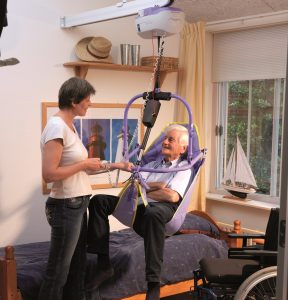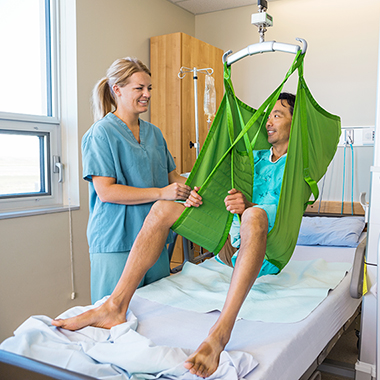
The lift, a valuable equipment!
What is a lift?
A lift is a specialized equipment that allows transferring a person without risking injury or hurting the person. The caregiver slides a sling under the person in order to safely raise and move the person to its final destination: the bed, the wheelchair, the toilet, the bathtub, etc.
Who is it designed for?
The lift is specifically designed for people who are no longer able to get up without significant help from a caregiver. They are also for people who can no longer stand up, change their position independently and make a transfer from bed to chair, bath or toilet. In these circumstances, the caregiver, whether a care professional or a family member is at risk of being hurt by the effort of helping a helpless person to carry out transfers. Whatever the weight of the sick or injured person, the risk of injury is still very present. The hoist becomes an essential equipment for everyone's safety.
Depending on the needs, there are three different types of lifts.
The floor lift allows lifting a person from the ground. It can be easily be moved, stored and retrieved when needed. Some models are foldable to facilitate transport to a different location. One of the most important benefits of this product is the ability to move close enough to someone who has fallen down and is having trouble getting up. This situation is unfortunately all too common in institutions or residences for seniors.
The fixed or portable lift is installed on permanent rails. Depending on the model, it has two or four functions. The two basic functions are obviously "go up" and "go down". The other two functions are moving left or right. With a two function lift, the caregiver has to push the user right or left onto the rail. With the four-function device, horizontal movements are operated by the control handle. A third lift model combines the two uses of the previous models, the removable and transportable ceiling lift. The posts and rail adjusts to the room and everything must be well "stuck" between the floor and the ceiling. Well adjusted, this lift remains safe. It is mostly used for temporary installations or even to be moved to a second home. This rail model is only available with a two-function device moving up and down.

What to install?
Analyzing the needs of the person and their environment is essential before making a decision on the appropriate model. Installing a ceiling rail requires to fix anchors in the building structure to ensure its solidity. In the absence of access to this structure, it is possible to install wall studs to support the rail.
There are several aspects to take into consideration in order to accommodate a person who needs a lift to make a transfer. For example, the configuration of the rails, the shower rod if necessary, the choice of the sling (model and size), etc. Above all, it is the needs and autonomy level of the person and caregivers that will dictate the choice of the appropriate equipment. The house configuration can also influence the selected type of equipment.
The maintenance of the lifts
Nobody wants to stay hanging in his sling with a lift that is out of order! Regular maintenance for this kind of equipment is essential. Ideally, you should have the motor, batteries, belt, controller and slings inspected once a year. It is mandatory to replace the belt and/or the sling as soon as a trace of wear appears. We strongly recommend carrying out a thorough annual inspection by an expert.
There are different types of slings
Slings without headrest are used for most transfers with a user that has a good head control. Those slings can be used to pick up a user from the ground.
Slings with headrest are often used in pediatric care or with a user who needs support to hold their head up.
Hygienic slings are ideal for hygiene care or to facilitate dressing.
The full body slings are suitable for users with low muscle tone, hip fracture, lower limb amputation or users that are agitated. This type of sling can remain under the user when seated. In that case, removing the belts under the thighs will avoid creating pressure points.
For more information, please visit: Quebec Institute for Rehabilitation in Physical Disability
Choosing the right equipment, installing it properly and securely, determining the right sling, are important steps in using a lift. This is the reason we consider it essential to consult experts and to have adequate training before using this equipment. We have to think about the safety of the user and the caregiver!
